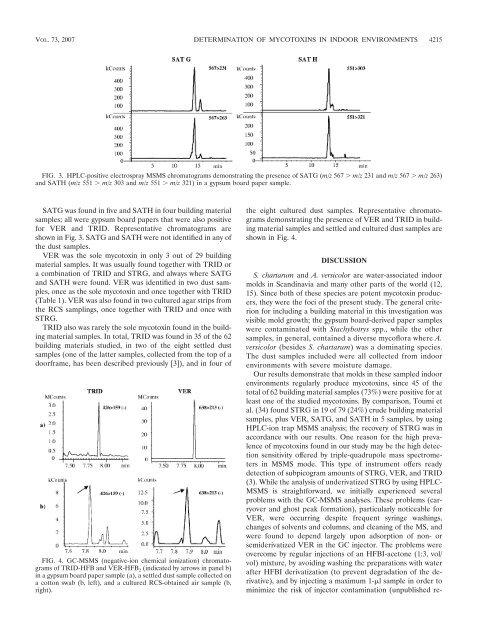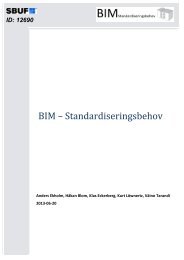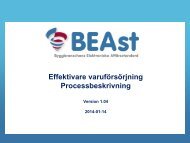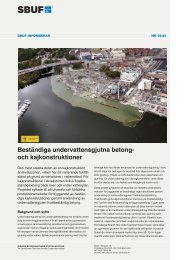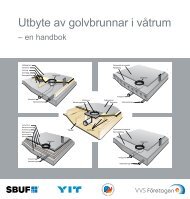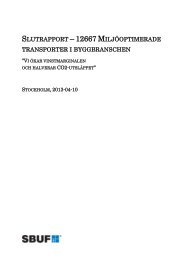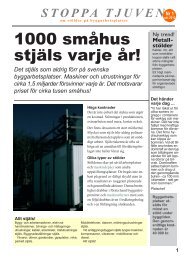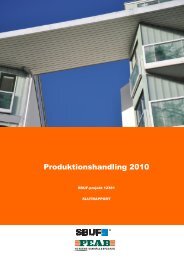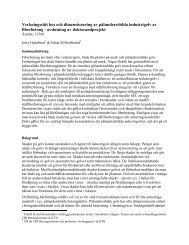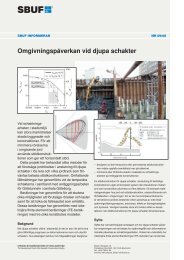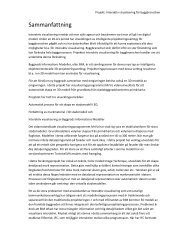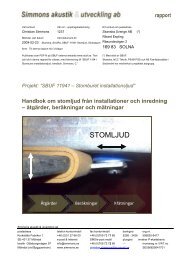Rapport SBUF-projekt: Mykotoxiner i inomhusmiljöer. Förekomst ...
Rapport SBUF-projekt: Mykotoxiner i inomhusmiljöer. Förekomst ...
Rapport SBUF-projekt: Mykotoxiner i inomhusmiljöer. Förekomst ...
Create successful ePaper yourself
Turn your PDF publications into a flip-book with our unique Google optimized e-Paper software.
VOL. 73, 2007 DETERMINATION OF MYCOTOXINS IN INDOOR ENVIRONMENTS 4215<br />
FIG. 3. HPLC-positive electrospray MSMS chromatograms demonstrating the presence of SATG (m/z 567 m/z 231 and m/z 567 m/z 263)<br />
and SATH (m/z 551 m/z 303 and m/z 551 m/z 321) in a gypsum board paper sample.<br />
SATG was found in five and SATH in four building material<br />
samples; all were gypsum board papers that were also positive<br />
for VER and TRID. Representative chromatograms are<br />
shown in Fig. 3. SATG and SATH were not identified in any of<br />
the dust samples.<br />
VER was the sole mycotoxin in only 3 out of 29 building<br />
material samples. It was usually found together with TRID or<br />
a combination of TRID and STRG, and always where SATG<br />
and SATH were found. VER was identified in two dust samples,<br />
once as the sole mycotoxin and once together with TRID<br />
(Table 1). VER was also found in two cultured agar strips from<br />
the RCS samplings, once together with TRID and once with<br />
STRG.<br />
TRID also was rarely the sole mycotoxin found in the building<br />
material samples. In total, TRID was found in 35 of the 62<br />
building materials studied, in two of the eight settled dust<br />
samples (one of the latter samples, collected from the top of a<br />
doorframe, has been described previously [3]), and in four of<br />
FIG. 4. GC-MSMS (negative-ion chemical ionization) chromatograms<br />
of TRID-HFB and VER-HFB 2 (indicated by arrows in panel b)<br />
in a gypsum board paper sample (a), a settled dust sample collected on<br />
a cotton swab (b, left), and a cultured RCS-obtained air sample (b,<br />
right).<br />
the eight cultured dust samples. Representative chromatograms<br />
demonstrating the presence of VER and TRID in building<br />
material samples and settled and cultured dust samples are<br />
shown in Fig. 4.<br />
DISCUSSION<br />
S. chartarum and A. versicolor are water-associated indoor<br />
molds in Scandinavia and many other parts of the world (12,<br />
15). Since both of these species are potent mycotoxin producers,<br />
they were the foci of the present study. The general criterion<br />
for including a building material in this investigation was<br />
visible mold growth; the gypsum board-derived paper samples<br />
were contaminated with Stachybotrys spp., while the other<br />
samples, in general, contained a diverse mycoflora where A.<br />
versicolor (besides S. chartarum) was a dominating species.<br />
The dust samples included were all collected from indoor<br />
environments with severe moisture damage.<br />
Our results demonstrate that molds in these sampled indoor<br />
environments regularly produce mycotoxins, since 45 of the<br />
total of 62 building material samples (73%) were positive for at<br />
least one of the studied mycotoxins. By comparison, Toumi et<br />
al. (34) found STRG in 19 of 79 (24%) crude building material<br />
samples, plus VER, SATG, and SATH in 5 samples, by using<br />
HPLC-ion trap MSMS analysis; the recovery of STRG was in<br />
accordance with our results. One reason for the high prevalence<br />
of mycotoxins found in our study may be the high detection<br />
sensitivity offered by triple-quadrupole mass spectrometers<br />
in MSMS mode. This type of instrument offers ready<br />
detection of subpicogram amounts of STRG, VER, and TRID<br />
(3). While the analysis of underivatized STRG by using HPLC-<br />
MSMS is straightforward, we initially experienced several<br />
problems with the GC-MSMS analyses. These problems (carryover<br />
and ghost peak formation), particularly noticeable for<br />
VER, were occurring despite frequent syringe washings,<br />
changes of solvents and columns, and cleaning of the MS, and<br />
were found to depend largely upon adsorption of non- or<br />
semiderivatized VER in the GC injector. The problems were<br />
overcome by regular injections of an HFBI-acetone (1:3, vol/<br />
vol) mixture, by avoiding washing the preparations with water<br />
after HFBI derivatization (to prevent degradation of the derivative),<br />
and by injecting a maximum 1-l sample in order to<br />
minimize the risk of injector contamination (unpublished re-


